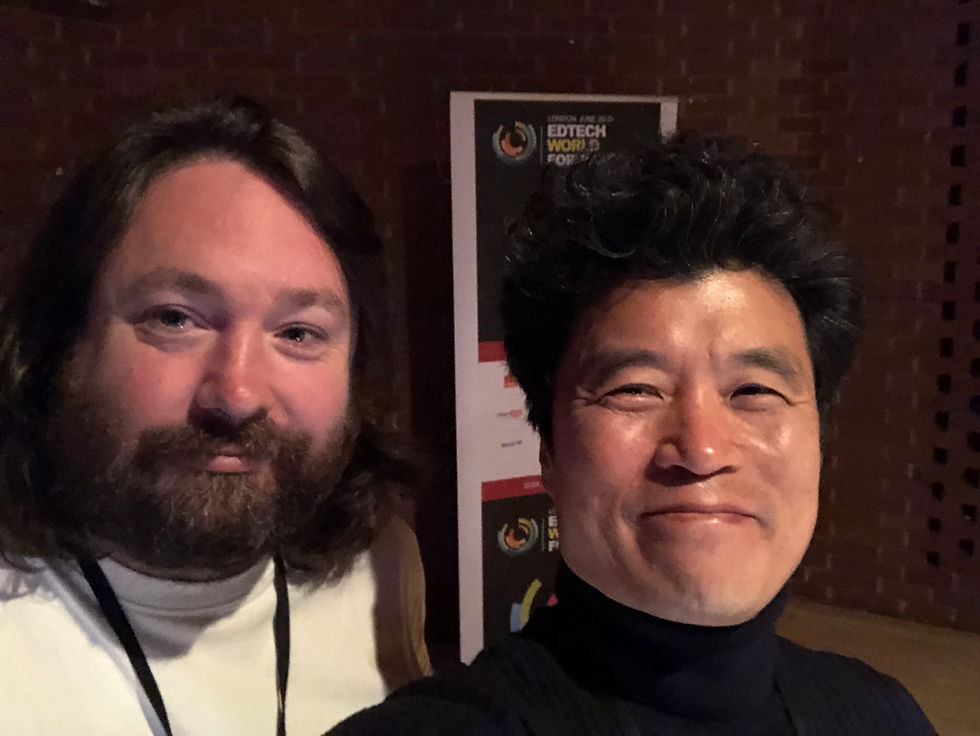Edtech World Forum 2024: Emerging perspectives on educational technology and higher education
- BJ

- 2024년 6월 23일
- 4분 분량

1. Key issues raised by Adam Webster, Deputy Head (Innovation), Caterham School
1.1 Culture and Change Management
Schools must learn to use technology effectively through trial and error, which is closely related to effective change management.
1.2 The importance of leadership
Successful technology integration requires strong leadership; collective effort alone is not enough.
1.3 Technology adoption challenges
Common challenges in adopting new technologies include lack of platform integration and redundant tasks.
1.4 The demanding customer
Schools are demanding customers and require technology providers to respond to their specific and frequently stringent requirements.
1.5 The reality and expectations of technology innovation
Over the past 25 years, many educational technology innovations have disappointed educators by failing to live up to expectations.
1.6 3D printing and augmented reality
While 3D printing has demonstrated its usefulness, augmented reality has yet to fully realise its potential in education.
1.7 The role of AI and chatbots
Although most schools are not fully prepared for AI, there are chatbot designs that can effectively respond to specific requirements.
1.8 Understanding the language of schools with AI
Chatbots designed for educational environments are customised to understand and respond to the specific language and demands of schools.
1.9 Safety and ethics
Addressing safety concerns arising from the adoption of technologies such as social media is critical in educational contexts.
1.10 Guiding students in the appropriate use of technology
It is important to provide a safe environment for students to use technology and make informed decisions.

2. Key issues from David Webster, Director of Education, Quality & Enhancement at The University of Liverpool, and Professor of Philosophy & Pedagogy
2.1 Rethinking Penalty and Embracing Chance in Learning
Rethinking Punishment: Rather than relying on punitive measures for non-compliance or misconduct, it is more effective to nurture students' intrinsic motivation and curiosity.
Randomness as a tool: Incorporate elements of randomness into assignments to stimulate creative thinking and recreate the unpredictability of the real world.
2.2 Addressing epistemic uncertainty
Embrace uncertainty: Encourage students to develop critical thinking skills and adaptability by recognising the uncertainty inherent in the acquisition of knowledge.
Flexible Curriculum: Design a curriculum that enables adaptability and the incorporation of new knowledge through interdisciplinary courses.
2.3 Human-centred approaches to learning
Serendipity in learning: Create opportunities for serendipitous encounters with knowledge that support exploration beyond the curriculum.
Collaborative learning: Facilitate a learning environment that emphasises collaboration over competition, encouraging collective intelligence and creativity.
2.4 Future Skills and Assessments
Redefine assessments: Transition away from conventional essay-based assessments to focus on higher-order thinking skills and real-world problem-solving tasks.
Skills Development: Identify and cultivate future-ready skills such as critical thinking, creativity, digital literacy and emotional intelligence.
2.5 Addressing academic integrity
Innovative assignments: Design assignments that are difficult to outsource or replicate using AI, with a focus on personalised projects.
Ethical Education: Integrate discussions of academic integrity and ethics into the curriculum to emphasise the value of original work.
2.6 Technology and education
Integrate technology thoughtfully: Use technology to enhance learning without replacing critical thinking and creativity.
Continuous learning for educators: Encourage educators to stay up-to-date with technological advances and adapt their teaching methods accordingly.
2.7 Transparency and Integrity
Promotion of Transparency: Promote transparency in academic policies and practices, including clear communication of policy origins.
Lead by example: To reflect the standards expected of students by adopting best practice in good faith.
2.8 Embracing change
Agility in policy and curriculum development: Regularly review policies and curricula to keep pace with technological and societal changes.
Frequent assessment updates: Continually update assessments to keep them relevant and effective.
2.9 Use technology
Integrative use of technology: Use technology to enhance the learning experience through adaptive learning platforms, virtual labs and AI-based tutoring systems.
Balancing online and face-to-face learning: Balance online resources with face-to-face learning to maximise benefits.
2.10 Continuous Professional Development
Educator Training: Provide ongoing professional development for educators to effectively integrate new technologies and pedagogical approaches.
Collaborative Learning Communities: Establish communities of practice for educators to share insights and strategies.
2.11 Protecting academic integrity
Robust integrity policies: Develop and implement reliable policies to protect academic integrity, including clear guidelines on plagiarism and the use of AI tools.
Ethics education: Integrate ethics education into the curriculum to create a strong sense of academic integrity.
2.12 Future-proofing education
Skills mapping: Conduct regular skill mapping to identify future workforce requirements and design curricula accordingly.
Lifelong learning: Support lifelong learning to encourage students to continually update their skills and knowledge.
2.13 Strengthening community and global engagement
Global collaboration: Use AI to facilitate global collaboration and learning, such as virtual exchange programmes and international research collaborations.
Community projects: Involve students in community projects that use AI for social good, demonstrating the societal impact of AI.
2.14 Conclusion.
Adapting to change: The future of higher education requires a proactive and flexible approach that embraces uncertainty, cultivates human qualities and redefines traditional assessments.
Quality education: By focusing on these areas, educators can prepare students for a world where knowledge is abundant and the ability to navigate, synthesise and apply it is key.









댓글